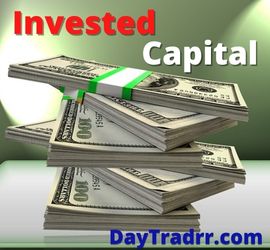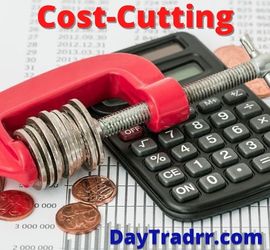What Is Invested Capital?
 Invested capital is the total investment by shareholders and bondholders when a company raises money by selling stock shares or issuing bonds. Debt, capital leases, and stockholder’s equity are all shown separately on the balance sheet. Therefore, invested capital is not a line item in the company’s financial statement.
Invested capital is the total investment by shareholders and bondholders when a company raises money by selling stock shares or issuing bonds. Debt, capital leases, and stockholder’s equity are all shown separately on the balance sheet. Therefore, invested capital is not a line item in the company’s financial statement.
The monies invested in a business during its life by shareholders, bondholders, and lenders are called invested capital. Non-cash assets can be supplied by shareholders. For example, the value of a building that is donated in exchange for shares. Or, the value of services rendered in exchange for shares. A corporation must make a return on its invested capital that exceeds the cost of that capital. Otherwise, the organization is steadily destroying the capital that was invested in it. As a result, invested capital is regarded as a financial analysis concept rather than an accounting notion.
Invested Capital – A Closer Look
Companies must generate greater earnings than the cost of raising capital from bondholders, shareholders, and other financing sources in order to earn an economic profit. Several criteria are used by businesses to assess how well they use that capital. This includes return on invested capital, economic value-added, and return on capital employed. A company’s total capitalization is the sum of debt issued including capital leases plus stock sold to investors. These two types of capital are reported in different sections of the balance sheet.
Example
Consider, for example, that Microsoft Corporation issues 1,000 shares of $200 par value stock at $300 per share. Microsoft adds the common stock balance for a total par value of $200,000 in the stockholder’s equity portion of the balance sheet. The remaining $100,000 received boosts the additional paid-in capital account. Next, Microsoft issues $100,000 in corporate bond debt. In that case, the balance sheet’s long-term debt column grows by $100,000. As a result, Microsoft’s capitalization rises by $400,000 as a result of the issuance of new stock and debt.
How Invested Capital Earns a Return
A successful company must maximize the rate of return on money raised. Investors pay close attention to how businesses use the revenues from issuing stock and debt. Assume a delivery company issues $500,000 in extra stock. They utilize the profits to purchase more delivery trucks. If the delivery company can use the additional vehicles to do more work, the company’s earnings will rise. As a result, it may even be able to pay a dividend to shareholders. The dividend raises each investor’s rate of return on a stock investment. Also, investors benefit from stock price gains caused by rising firm earnings and sales.
A stock repurchase plan reduces the number of shares outstanding and also lowers the equity balance. This occurs by using a portion of earnings to buy back previously issued stock and retiring the shares. Analysts often pay particular attention to a company’s earnings per share (EPS). The metric represents the net income earned per share of stock. When a company repurchases shares, the number of outstanding shares declines. In turn, this boosts EPS and makes the stock more appealing to investors.
How Companies Use Invested Capital
Invested capital is a source of cash for a firm that allows it to pursue new opportunities such as expansion. Within a firm, it serves two purposes. For starters, it is used to acquire fixed assets such as land, buildings, or equipment. Second, it is utilized to fund day-to-day running expenses such as inventory purchases and personnel salaries. A corporation may select invested capital funding over a bank loan for a variety of reasons. When a firm issues stock shares, for example, it is under no obligation to pay dividends. When opposed to paying interest on a bank loan, this makes it a low-cost source of funding. Smaller companies may not qualify for a large bank loan with a low-interest rate. However, it may still elect to get financing through shares and bonds.
An investor can evaluate invested capital using criteria such as the return on invested capital (ROIC) ratio. An investor will use this ratio to determine the value of a company. A greater ratio implies that a company is a value creator. As a result, it uses invested cash to generate larger earnings than other companies. The ratio demonstrates a company’s capacity to drive sales through its capital by dividing revenue by capital invested. A company having a greater ratio than its competitors indicates that it is functioning more efficiently.
Return on Invested Capital (ROIC)
The return on invested capital (ROIC) computation is used to evaluate a company’s efficiency. It measures how a company allocates capital under its control toward profitable utilization. The return on invested capital ratio indicates how well a corporation uses its money to generate profits. Return on invested capital (ROIC) can be compared to the weighted average cost of capital (WACC). Together, these measures show whether invested capital is being employed successfully. This metric is also known as return on capital.
ROIC is represented as a percentage and is commonly annualized or a trailing 12-month number. To establish whether a company is creating value, it should be compared to its cost of capital. If a firm’s ROIC exceeds its weighted average cost of capital (WACC), the most often used cost of capital metric, value is created. As a result, these firms will trade at a premium. A return in excess of 2% of the firm’s cost of capital is a frequent indicator of value generation. A corporation is deemed a value killer if its ROIC is less than 2%. Some businesses operate at a zero-return level. While they are not destroying value, they do not generate surplus money to invest in future growth.
ROIC is one of the most significant and useful valuation indicators. However, it is more crucial for some industries than others. This is because some companies invest significantly more capital than others that require less equipment.
Return On Invested Capital – Pitfalls & Drawbacks
There are a few drawbacks to using ROIC. Many businesses operate in various markets. Some may require a lot of capital, while others may not. They could be in completely different industries from one another. ROIC considers the entire firm’s operations. Therefore, it might be difficult to determine whether the majority of value is generated by a particular section. Or, if the entire organization produces high investment returns.
- Different industries have different norms – The metric is less useful to some businesses than others. For example, using ROIC to analyze financial organizations will result in a muddle. This is because banks and insurance companies use capital as part of the products they offer.
- Accounting factors – Some variables may result in deceptive ROIC figures. A corporation with a lot of intangibles like goodwill or copyrights on its balance sheet, for example. These will have a lower ROIC due to the larger denominator. If a company deducts intangibles, you’ll need to make modifications to complete a valid historical ROIC study.
- Definition of debt – Excessive capital leases in comparison to competitors may potentially affect ROIC analysis results unless lease modifications are made. Excess cash on hand reduces ROIC until it is adjusted. Because cash isn’t truly invested capital, any excess cash should be deducted from net working capital.
- Anomalies and non-recurring events – A one-time occurrence that results in a large gain or loss might have an impact on earnings. As a result, it should not be used to evaluate routine business operations. When comparing ROIC across organizations, it is important to account for variances in balance sheets and anomalies in income statements.
Up Next: What Is Cost-cutting?
 Cost-cutting occurs when an organization strategically reduces expenditures and directly implements measures to improve profitability. Measures implemented by a corporation to cut costs and expenses while boosting profitability are referred to as cost reduction. These steps are often taken when a company is in financial difficulties or during an economic slump. They can also be implemented if a company’s management anticipates future profitability concerns. In that case, cost-cutting might become part of the corporate strategy.
Cost-cutting occurs when an organization strategically reduces expenditures and directly implements measures to improve profitability. Measures implemented by a corporation to cut costs and expenses while boosting profitability are referred to as cost reduction. These steps are often taken when a company is in financial difficulties or during an economic slump. They can also be implemented if a company’s management anticipates future profitability concerns. In that case, cost-cutting might become part of the corporate strategy.
The most typical motive for a company to decrease expenses is to increase profits. However, there are other reasons to implement a cost-cutting program. For example, if a company wishes to fund new technology or expansion into a new market. It can minimize existing costs rather than obtaining funds elsewhere. In order to compete more successfully in its industry, a business may seek to minimize expenditures.




